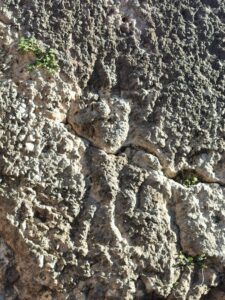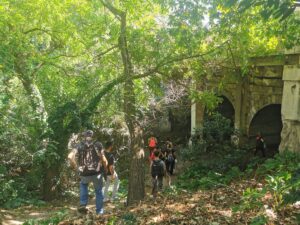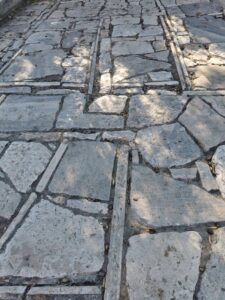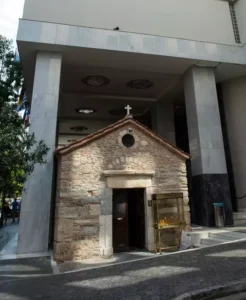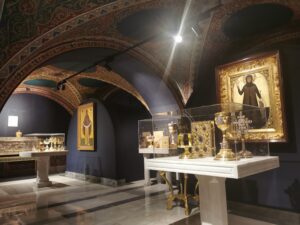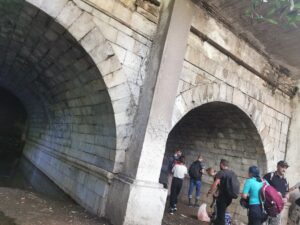Lesser known attractions in Athens, Part 1
- Today's route, about 3 km
- Dexameni/Δεξαμενή, the Hadrian water reservoir
- The park at Split Rock or Little Lykabettos
- Ziller Mansion/Loverdos Museum
- Historical site: 1941-1944, Gestapo detention center
- The wall of Themistocles in the staircase
- A few words about the arcades of Athens
- The catacombs beneath the Russian Church
- Next tour among lesser-known attractions in Athens
- Beyond the bridge of Ilissos
Join a fascinating tour of Athens’ lesser-known sights. Discover secret vaults, subterranean passages, crypts and catacombs, hidden beneath the commercial streets of the city center. Walk on unmapped paths, step into underground treasure chambers, visit unknown museums, and see the city with new eyes, in a different way.
Today’s route, about 3 km
Today, we will walk from the trendy Kolonaki, through the commercial center of Athens, to the outskirts of the well-known Plaka district and the hidden arched bridge over the Ilissos river. The entire route through these lesser-known sights of Athens is approximately 3 km and is best explored on foot.
We start at the Dexameni/Δεξαμενή square, located on the western slope of the Lykabettos hill, not far from the central square of Kolonaki.
Dexameni/Δεξαμενή, the Hadrian water reservoir
One of Athens’ lesser-known but still exciting sights is the Hadrian’s Reservoir. The reservoir was part of the impressive aqueduct system built in the 10th century AD by the Roman emperors Hadrian and Antoninus Pius. The system ran 25 kilometers underground and provided the city with drinking water from the springs of Mount Parnitha for many centuries. During the Ottoman period, the viaduct was abandoned but reopened in the 19th century.
Then, for over a century, the aqueduct served as the main source of drinking water for the growing capital. However, it was abandoned in 1940 in favor of more modern systems. Today, the water is solely used for irrigation.
Dexameni Square, named after the reservoir, was a significant meeting place for Greece’s cultural and intellectual elite in the early 20th century. It attracted numerous famous writers, painters, and other artists, including Kazantzakis, Papadiamantis, Sikelianos, and others.


The Hadrian’s Reservoir is presently closed for restoration. However, visitors can still view the interior through large glass windows that enclose the building’s facades. Currently, it only opens once a year on Epiphany Day, celebrated on January 6th, when the church sanctifies the city’s water. For more information about Epiphany Day, please click here>>.
According to the Greek Water Authority (EYDAP), the reservoir will be open to the public by 2025.
Dexameni Square has several popular cafés and ouzeries that are frequented, notably by students. During the summer months, you can enjoy open-air cinema shows on the roof terrace of the cistern itself. The small cinema, Cine Dexameni, is run by the EYDAP cultural association. You can find the summer program on their website here >> (In Greek).
The park at Split Rock or Little Lykabettos
It may seem unbelievable to those who have enjoyed a refreshing walk at Lykabettos, but in the mid-19th century, the entire area, which includes two hills, one larger and one smaller, was a barren and harsh landscape, with very little vegetation, if any. It was inhabited only by a few shepherds. It’s no surprise that the entire district was known as Katsikadika, the land of goats. During the planning of the new capital, a profitable business idea emerged to construct a limestone quarry on the smaller of the two hills, which was later named Little Lykabettos.


The quarried stone was primarily used to construct the many “neoclassical” houses that were becoming increasingly common in the growing young capital and, although awareness of the aesthetic and ecological value of the area gradually increased over time, quarrying continued until 1960, when it was finally banned altogether.
The park at Split Rock, one of the lesser-known attractions in Athens, is the remaining portion of such an old quarry. Due to the surrounding high-rise residential buildings, Lykabetto’s smaller sibling can no longer be recognized as a hill. However, visitors will be rewarded for their efforts to reach the park, as it resembles a natural balcony and offers an outstanding view. Beyond the Acropolis, one can see all the way to Piraeus, and above the visitor’s head rises the majestic big brother Lykabettos, adorned by the small church of Agios Georgios at the top.
Although some claim otherwise, there is no evidence that the Split Rock is anything other than a geological formation. Nevertheless, many fanciful legends and myths about its mysterious powers have long circulated in some circles.
Ziller Mansion/Loverdos Museum
We walk a few hundred meters down the western slopes of Lykabettos hill towards the city center. At number 58 on Akadimias Street we come across a rather unpretentious and inconspicuous facade of an old house. As worn and scribbled as it is, it is rarely noticed by the many pedestrians who hurry by.



The Loverdos Museum occupies the entire block at the corner of streets Akadimias and Mavromichali. The museum’s central entrance is located at Street Mavromichali 6.
You can visit the museum’s website at http://loverdosmuseum-bma.gr/ for more information. Admission to the museum is free.
The huge three-storey neoclassical building is constructed skillfully on multiple levels and features a variety of interior spaces including large halls, smaller rooms, corridors, internal staircases, marble floors, colonnades, mosaic walls, verandas, balconies, a courtyard, as well as one small private Orthodox chapel, and a small garden.
Ernst Ziller (1837-1923) was a German architect, professor, and archaeologist who influenced Greek urban development in the 19th and 20th centuries. He was one of the most important architects in Greece, designing and supervising the construction of hundreds of public and private buildings throughout the country. Ernst Ziller left his indelible imprint on Greek urban development in the late 19th and early 20th centuries.
Ziller’s private mansion was eventually taken over by the banker and art collector Dionysios Loverdos, who converted the building to house his collections, which are now on display in the museum. The collections include woodcarvings, stained glass, paintings, sculptures, icons, rare manuscripts, and various other crafts.
Historical site: 1941-1944, Gestapo detention center
We now move closer to the city center, to Korai Street. This street intersects with two major roads, Stadiou and Panepistimiou. In the basement of Korai Street no. 6, the detention center of the German kommandantur during the occupation years 1941-1944, has been preserved and restored.

The conservation and restoration work on the premises was carried out by the property owners, Ethniki Asfalistiki Insurance Company, in collaboration with the Greek State Ministry of Culture. The philosophy behind the work was to intervene as little as possible, offering visitors a journey through time to listen to the stories of the scribbled walls and found objects about those who were imprisoned here.


The wall of Themistocles in the staircase
In the very heart of Athens, near Klauthmonos/Κλαυθμώνος Square, and more specifically at Dragasaniou Street 6, there is an old arcade, unused and abandoned, probably since the post-war period. If you venture down the desolate staircase, you will encounter something strange, to say the least. Suddenly, a section of the ancient Athenian defensive wall appears, harmoniously interwoven with the foundations of the modern skyscraper. A small blurry sign on the adjacent wall informs us that what we are seeing is one of the few remaining sections of the famous Themistocles Wall, dating from the 5th century BC.





A few words about the arcades of Athens
If you have walked around central Athens, you will have noticed the extensive network of characteristic passageways or arcades on the ground floors of tall modern buildings. You could say that the arcades act as small shopping malls connecting the main central streets. In Greek, they are called εμπορικές στοές, which means commercial galleries or passageways.
The arcades house not only shops, but also cafes, offices, workshops, and sometimes even theaters or cinemas. The arcades are excellent shortcuts between the different parts of the city center, away from the crowded streets, sheltered from the rain in winter and pleasantly cool in summer. In a way, they form their little city within the city.

Many of the arcades, especially in recent decades, have fallen into disrepair and are no longer the vibrant commercial and social centers they once were. However, they are still an integral and important part of the cityscape and are, despite being so common, one of the lesser-known attractions in Athens. Some of them, as we have seen, can be quite surprising.
The catacombs beneath the Russian Church
We move on to the outskirts of the Plaka district and the Street Filellinon/Souri junction, where the church commonly known as Russian Church is located. Under a metal hatch on the marble floor in the nave, an admirable and hidden world is revealed, unknown even to most Athenians. A world full of priceless archaeological finds.
The cellars were discovered during the restoration of the church in 1855 and have since given rise to countless myths and legends. It should be noted that the Russian Church (officially the Church of the Holy Trinity), run by the Russian community of Athens, is one of the oldest and largest Byzantine monuments in the whole of Attica region.

The underground vaults bear clear traces of several eras and civilizations of archaeological remains, stored and stacked on top of each other. The cellars, which are not catacombs in the classical sense, have been used in different ways over the centuries by different religions and cultures. Indeed one of the lesser-known attractions in Athens.
Remains of a sanctuary from Greek antiquity can be recognized, probably dedicated to the god Apollo. The Romans built baths on the same site, and much later a Byzantine monastery was finally built on top of everything, with the underground spaces used as crypts and ossuaries.


Civil engineer and speleologist Panagiotis Deuteraios, who has examined and explored the vaults in detail, informs us that the picture we see today, with the archaeological finds stacked on top of each other, is the result of the restoration of the church in 1855. The underground chambers were indeed rebuilt, but do not seem to have served any other purpose since then, other than being a temporary museum for that period, he says.
Next tour among lesser-known attractions in Athens
In the next tour, we will peek at some of the secrets hidden in the Greek capital. Among others, we will explore the Frog Island/Βατραχονήσι and the Ilissos River basin – an unknown wild oasis hidden in the middle of the city center, right at the intersection of several major highways. In its vicinity, if we are lucky, we will also see a rare relief of the god Pan, a relief visible … only occasionally.
Next, the walk takes us past two small but not insignificant Greek chapels: the Holy Power and the Little Metropolis. We will also descend the narrow medieval stairs to the treasury of the central Metropolis Cathedral, and then follow the Hiridanos stream – the aorta of ancient Athens, running underground where you least expect it. Next, we’ll make our way up Filopappou Hill on the artful footpath created by the famous architect Dimitris Pikionis, and finally make some short stops at lesser-known museums that are well worth a visit.
Beyond the bridge of Ilissos
From the stone arch bridge, you can follow the Ilissos river channel underground to its outlet at Faliron, near Piraeus. As you can see in the video below, the Greek Expedition took part in such an impressive and exciting tour beneath the traffic routes and urban agglomeration of the Greek capital.
The entire series of articles on the lesser-known attractions in Athens is based on tours with the Terra Incognita team, led by speleologist and civil engineer Panagiotis Deuteraios.
Follow the Expedition on Facebook, Instagram and Linkedin, for updates and further information.
Sources:

